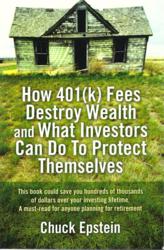Equity mutual fund investors are incurring unfair trading costs of up to $10 billion annually, which penalizes long-term investors. The industry knows about this problem, but does not want to correct it, even if there is a viable solution, according to financial expert Seymour Sacks. Here are some reasons for the industry’s resistance to change.
Tacoma, Washington (PRWEB) November 19, 2012
Hidden costs are one of the best kept secrets in the mutual fund industry.
Now, a new research paper points out that investors in equity funds are incurring trading and market impact costs of up to $10 billion annually and considerably more if you include all mutual funds. This is due to the current unfair pricing of mutual fund shares.
In practice, new, liquidating shareholders in mutual funds are not paying their portion of trading commissions that are deducted when they build their current portfolios. But the way the fund industry is structured, long-term buy-and-hold investors assume these costs over time, thus transferring their wealth to new and liquidating shareholders, many of them who are short-term traders. As a result, wealth is transferred to new and liquidating shareholders, many of whom are short-term traders.
In practice, long-term holders, many of whom are saving for retirement, pay an unfair amount of the portfolio brokerage and market impact costs. Shareholders who trade frequently should pay for the churning and the additional costs they create.
The most equitable solution is for the fund’s accrued commissions to get added to the fund’s net asset value (NAV) per share for new purchasers and subtracted from net asset value per share for liquidating shareholders.
But while this would be a fair practice for all shareholders, it is complicated by the fact that fund management companies are compensated based on the assets under management (AUM) of their funds. Since there are many high-frequency short-term traders, many fund companies recognize that correcting this problem could reduce fund AUM’s, which, in turn, would reduce fund company revenues.
In the paper, http:// “Mutual Fund Liquidity and Fiduciary Conflicts of Interest,” professors Miles Livingston of the University of Florida, and David Rakowski, associate professor of finance at Southern Illinois University, address this important, but esoteric, problem and suggest that fund companies begin to charge fees for purchasing and redeeming mutual fund shares. These fees would then become part of the fund’s assets and compensate long-term, buy-and-hold investors, who provide liquidity for more active traders. “This procedure reduces the incentives for the use of mutual funds as short-term trading vehicles,” the professors write.
This proposal also addresses the conflict-of-interest that exists between portfolio managers and their non-trading fund shareholders. Because fund managers are compensated based on the fund’s AUM, long-term buy-and-hold, non-trading investors, “who do not purchase or redeem shares, unfairly bear the majority of these costs,” the paper states.
Addressing Conflicts-of-Interests
This conflict of interest between non-trading investors and trading investors exists “because mutual fund advisers’ compensation is usually a percentage of net assets under management and because providing liquidity tends to increase the average amount of assets under management. But there is also a conflict of interest between advisers and non-trading investors. As a result “the non-trading investors bear the cost and the advisers receive benefits from increased management fees – a clear conflict-of-interest. “
But under existing fund industry practices, since buy-and-hold investors do not know the revenue generating role they serve in complex mutual fund organizations, they are compensated for their critical role. This is one way fund managers receive large salaries based on fund AUMs, which are being supported by passive, naïve investors.
To compensate for this cost disparity between short- and long-term fund investors, as well as rectifying this conflict-of-interest, a 50-year veteran of the securities industry has developed a patented algorithm which levels the playing field.
Seymour Sacks has developed the Sacks Equalization Model (SEM), which adds portfolio brokerage commissions for purchasing shares to the purchase price. The revenue generated by this mark-up is returned to the general revenues of the fund. The price paid to redeeming investors is the net asset value minus brokerage costs incurred to sell some of the fund’s securities. The algorithm is flexible enough to incorporate market impact costs incurred when there are redemptions or new purchases. Sacks estimates that since the algorithm improves expense management, it can add up to an additional 1% return on performance, thus benefitting long-term traders and not harming AUM.
This pricing disparity is also raised in the book, “How 401(k) Fees Destroy Wealth and What Investors Can Do About It.” In the book, author Chuck Epstein writes that the disproportionate allocation of trading costs among fund investors is well known, and favors active traders. “In an ideal situation, all investors in a fund would pay their trading costs on a proportional basis to reflect their investment balances in the fund,” Epstein said.
So if the fund industry has an opportunity to correct a conflict-of-interest, while also improving returns, why hasn’t the fund industry moved?
According to Sacks, the Investment Company Institute, the mutual fund trade association, said it is aware of the problem, but it was too expensive to implement. In a conversation with ICI executives, Sacks noted that funds now routinely have separate prices for different share classes, so implementing new share prices to compensate long-term traders would not be a radical change. When Sacks made this point, ICI officials did not respond, he said.
While these may be esoteric issues to most fund investors and many in the financial media, unfair pricing is one of many other fund practices, such as 12b-1 fee, revenue sharing and the failure to adopt an industry fiduciary standard, that all work to create conflicts-of-interest between the mutual fund industry and its own customers. Still, these are important questions any pro-consumer industry group should be ready to solve.
Contact
- Charles Epstein
Charles Epstein Consulting
(253) 226-6339
Email
- Chuck Epstein
Charles Epstein Consulting
(253) 226-6339
Email
















